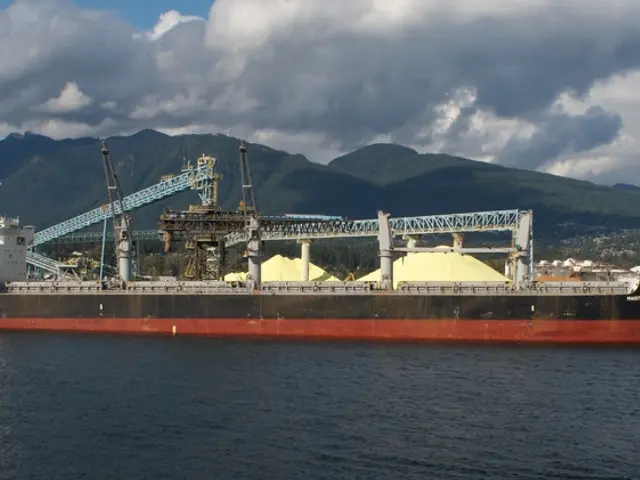Eruptions Persist in Kaluapele: Lava Fountains Reach 20th Episode
Lava Frenzy at Kilauea's Summit: An Unprecedented Display of Power
From December 2024 to May 2025, the summit of Kilauea volcano has hosted an extraordinary show, with 20 episodes of lava fountaining within the Halemaʻumaʻu crater. Let's dive into the astonishing details of this geological spectacle.
The Dynamic EruptionsThis series of episodic events has captivated scientists and spectators alike, with each episode showcasing unique characteristics. The length of each episode varies wildly, from a mere 4.5 hours (episode 20) to a remarkable 8.5 days (episode 3), with a majority of episodes wrapping up within a day. Interestingly, many episodes included dual fountains, a rare phenomenon not only at Kilauea but globally.
Twin Fountains, Impressive HeightsThese fountains have been seen to erupt from two vents at the base of the western wall of Halemaʻumaʻu crater. These vents, known as the north and south vents, have taken turns dominating the show. Occasionally, the south vent has spectacularly shot lava over 1,000 feet high, while the north vent usually displays low-level spattering or lava ponding.
Feeding the CraterThese towering lava fountains have fed lava flows, some more extensive than others, gradually filling the crater formed during the 2018 summit collapse. In some areas near the vents, the lava flows are nearly 200 feet thick, and they have covered a total area of 816 acres.
The IntermissionThe intervals between eruptions, known as repose periods, have ranged from 16 hours to 12 days. During these pauses, intermittent spattering and occasional lava flows have occurred.
Blown Away by the ElementsThese impressive lava fountains have resulted in tephra (lava fragments) and Pele's hair (volcanic glass fibers), with the distribution of tephra primarily controlled by prevailing wind patterns. Most commonly, trade winds blow to the southwest, resulting in tephra accumulating in the closed area of Hawaii Volcanoes National Park. However, during slack and Kona winds, tephra and Pele's hair have fallen on the summit region around Volcano village, the Volcano Golf Course, and along Highway 11.
Tracking the Volcanic ActivityDespite the hazards, the USGS Hawaiian Volcano Observatory continues its tireless monitoring and livestreaming efforts, documenting the eruption's evolution, informing hazard assessments, and keeping the public informed. Through their diligence, we can appreciate the spectacular beauty of these eruptions, understanding the intricate dance of magma, air, and rock that unfolds at the summit of Kilauea.
Stay Informed, Stay SafeKilauea continues to erupt episodically, with its USGS Volcano Alert level set at WATCH. Please visit the HVO's website for updates, volcano photos, maps, earthquake information, and more. Stay safe, and remember to always be mindful of the ever-shifting volcanic landscape and the associated hazards.
[1] Hawaiian Volcano Observatory (HVO). (n.d.). Kilauea summit eruption. Retrieved May 7, 2023, from https://volcano.si.edu/volcano.cfm?vn=KIL[2] USGS. (n.d.). Hawaiian Volcano Observatory (HVO) Observations of the Holuhia cone. Retrieved May 7, 2023, from https://www.usgs.gov/volcanoes/kilauea/hvo-observations-holuhia-cone[3] USGS. (n.d.). Kilauea summit eruption impresses with dual fountains. Retrieved May 7, 2023, from https://volcano.si.edu/observations/2025/04/23/kilauea-summit-eruption-impresses-with-dual-fountains[4] USGS. (n.d.). Kilauea summit eruption ends after 4.5 hours of lava fountaining. Retrieved May 7, 2023, from https://volcano.si.edu/observations/2025/05/06/kilauea-summit-eruption-ends-after-4.5-hours-of-lava-fountaining
- The series of episodes at Kilauea's summit, from December 2024 to May 2025, have provided valuable data for environmental-science, space-and- astronomy, and data-and-cloud-computing professionals studying volcanoes.
- Living up to its reputation as one of the most dynamic volcanoes globally, Kilauea's vigorous activity has not only been captured by the USGS Hawaiian Volcano Observatory through livestreams but has also been the subject of rigorous scientific analysis using cutting-edge technology such as tiltmeters.
- Researchers in the field of environmental-science and volcanology are closely monitoring Kilauea's ongoing eruptions, analyzing the collected data to better predict the outcomes of these powerful, yet captivating geological events.
- In response to the mesmerizing 20 episodes of lava fountaining at Kilauea's summit, scientists, together with interested spectators, have joined forces to discuss new findings and collaborate on projects, furthering the field of science and our understanding of volcanoes.
- As Kilauea continues to demonstrate its awe-inspiring power with these unprecedented displays, it serves as both an educational tool for the public and a valuable case study for the continued advancement of science and technology dedicated to the study of volcanoes.




